
The Asilidae are the robber fly family, also called assassin flies. They are powerfully built, bristly flies with a short, stout proboscis enclosing the sharp, sucking hypopharynx. The name "robber flies" reflects their expert predatory habits; they feed mainly or exclusively on other insects and, as a rule, they wait in ambush and catch their prey in flight.

Perdita is a large genus of small bees native to North America, particularly diverse in the desert regions of the United States and Mexico. There are over 600 currently recognized species of Perdita, plus more than 100 additional subspecies and many more species that remain undescribed. Perdita are usually quite small and often brightly colored with metallic reflections and/or yellow or white markings, and among the few lineages of bees incapable of stinging. The genus was extensively treated by P.H. Timberlake who, in addition to T.D.A. Cockerell, described most of the known species. Most species are extreme specialists (oligoleges) with respect to pollen and will only collect pollen from a few closely related species or genera of plants. Many species in this genus are called fairy bees.

Paeonia broteri is a perennial, herbaceous species of peony. It is an endemic species of the Iberian Peninsula. It bears rose-pink highly fragrant flowers about 12 cm wide and glossy green leaves. It reaches up to 40 centimetres (16 in) in height.
Bombus cockerelli, Cockerell's bumblebee, is a yellow and black bumblebee known only from fewer than 30 specimens, collected at a few high-altitude localities in the White Mountains of New Mexico, all within an area of less than 300 square miles (780 km2), giving it the smallest range of any of the ~250 species of bumblebees in the world.
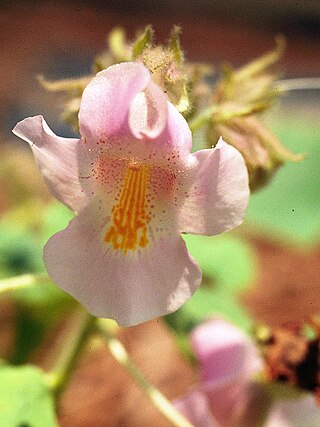
Proboscidea louisianica is a species of flowering plant in the family Martyniaceae. Its true native range is unclear, but probably includes parts of the southwestern United States and Mexico in North America. It occurs in other areas, including other regions in North America, Europe, Australia, and South Africa, as an introduced species. It is the most widely distributed species in its family. Common names it shares with other Proboscidea species include devil's claw and unicorn-plant. Names more specific to the species include common devil's claw, ram's horn, aphid trap, Louisiana unicorn-plant, purple-flowered devil's-claw, goat's head, elephant tusks, and martinoe.

Polyzoniida is an order of millipedes in the subterclass Colobognatha. This order contains three families and more than 70 described species. The species in this order are also known as camphor millipedes, because ozopore secretions in this order frequently have a strong camphor-like smell. Poison frogs in South America and Madagascar evidently obtain some of their poison from these millipedes.
Friseria cockerelli, the mesquite webworm moth, is a moth of the family Gelechiidae. It is found in Mexico and the southern United States, where it has been recorded in the states of Texas, New Mexico, Arizona, Colorado, California, Oklahoma and Nevada.

Novomessor ensifer is a species of ant endemic to Mexico. A member of the genus Novomessor in the subfamily Myrmicinae, it was first described by Swiss entomologist Auguste Forel in 1899. N. ensifer was originally a part of the genus Aphaenogaster until a recent phylogenetic study concluded that Novomessor was genetically distinct and should be separated. The ant is a medium-sized species, measuring 5.5 to 10 millimetres. The ant is ferruginous-colored in some certain parts of the body, and small workers (nanitics) in incipient colonies are noticeably different in color and body structure.

Novomessor albisetosus, also known as the desert harvester ant, is a species of ant found in the United States and Mexico. A member of the genus Novomessor in the subfamily Myrmicinae, it was first described by Austrian entomologist Gustav Mayr in 1886. It was originally placed in the genus Aphaenogaster, but a recent phylogenetic study concluded that it is genetically distinct and should be separated. It is a medium-sized species, measuring 6 to 8.5 millimeters and has a ferruginous body color. It can be distinguished from other Novomessor species by its shorter head and subparallel eyes.
Centris cockerelli is a species in the family Apidae, in the order Hymenoptera . The distribution range of Centris cockerelli includes Central America and North America.
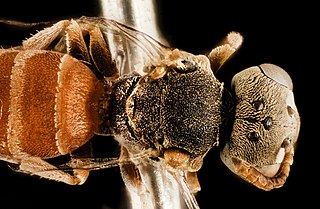
Neolarra vigilans is a kleptoparasitic species of cuckoo bee in the family Apidae. It is found from northern Mexico to southern Canada.

Neolarra is a genus of cuckoo bees in the family Apidae. There are about 16 described species in Neolarra, all from North America. These bees are smaller than a grain of rice and are kleptoparasites of Perdita bees.
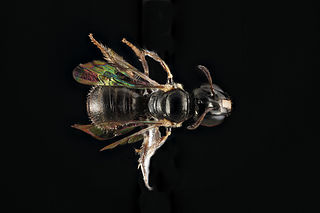
Ceratina cockerelli is a species of small carpenter bee in the family Apidae. It is found in the Caribbean Sea and North America.

Dicromantispa sayi, or Say's mantidfly is a species of mantidfly in the family Mantispidae. It is found in the Caribbean Sea, Central America, and North America.
Protandrena cockerelli is a species of bee in the family Andrenidae. It is found in North America.
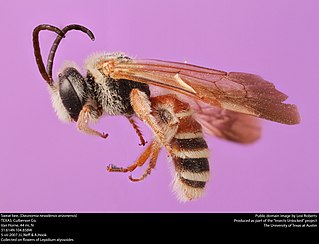
Dieunomia nevadensis, the Nevada nomia, is a species of sweat bee in the family Halictidae. It is found in Central America and North America. It was first described by Ezra Cresson in 1874.
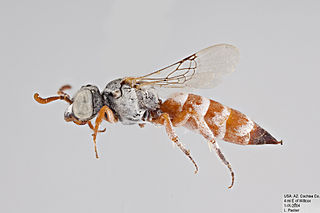
Neolarra verbesinae is a species of cuckoo bee in the family Apidae. It is found in North America.
Neptosternus starmuehlneri, is a species of predaceous diving beetle found in Sri Lanka.

Laccophilus inefficiens, is a species of predaceous diving beetle found in India, Bangladesh, Bhutan, Myanmar, Nepal, Pakistan, Sri Lanka, China, Hong Kong, Japan, Taiwan, Vietnam, Laos, Thailand, Indonesia, Iran and Malaysia.
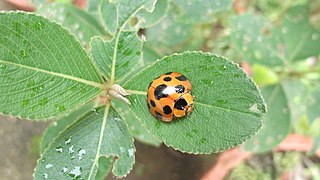
Synonycha grandis, commonly known as Giant bamboo ladybird, is a species of lady beetle found in Australia, Oceania and Southern Asia.














